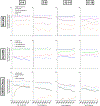Trends in Pediatric Central Nervous System Tumor Incidence in the United States, 1998-2013
- PMID: 30464022
- PMCID: PMC6401271
- DOI: 10.1158/1055-9965.EPI-18-0784
Trends in Pediatric Central Nervous System Tumor Incidence in the United States, 1998-2013
Abstract
Background: Brain and other central nervous system (CNS) cancers are the leading cause of U.S. pediatric cancer mortality. Incidence trends can provide etiologic insight. We report trends in incidence rates of pediatric malignant CNS cancers and pilocytic astrocytoma (nonmalignant but historically registered) in the United States.
Methods: Age-standardized incidence rates and annual percent changes (APC) in rates during 1998 to 2013 were calculated for children aged 0 to 19, stratified by subtype, age, sex, and for gliomas, histology and location. We estimated the absolute change in number of cases diagnosed U.S.-wide during 2013 compared with the expected number of cases had 1998 rates remained stable.
Results: Rates of all pediatric malignant CNS cancer combined (n = 18,612) did not change [APC: 0.16; 95% confidence interval (CI): -0.21-0.53]. There were statistically significant changes in several subtypes; however, glioma incidence (n = 10,664) increased by 0.77% per year (95% CI: 0.29-1.26), embryonal cancer rates (n = 5,423) decreased by 0.88% per year (95% CI: -1.33 to -0.43), and pilocytic astrocytoma rates (n = 6,858) increased by 0.89% per year (95% CI: 0.21-1.58). Of the 1,171 malignant tumors and 450 pilocytic astrocytomas diagnosed in U.S. children in 2013, we estimated 120 excess gliomas, 94 excess pilocytic astrocytomas, and 72 fewer embryonal CNS tumors than would be expected had 1998 rates remained stable.
Conclusions: The gradual changes in incidence we observed for specific types of pediatric CNS cancers are likely due to a combination of changes in classification and diagnosis and true changes in CNS cancer.
Impact: Continued surveillance of pediatric CNS tumors should remain a priority, given their significant contribution to pediatric cancer-related deaths.
©2018 American Association for Cancer Research.
Conflict of interest statement
The authors declare no potential conflicts of interest.
Figures

References
-
- Black WC. Increasing incidence of childhood primary malignant brain tumors--enigma or no-brainer? J Natl Cancer Inst 1998;90(17):1249–51. - PubMed
-
- Smith MA, Freidlin B, Gloeckler Ries L, Simon R. Trends in Reported Incidence of Primary Malignant Brain Tumors in Children in the United States. 1998. - PubMed
Publication types
MeSH terms
Grants and funding
LinkOut - more resources
Full Text Sources

